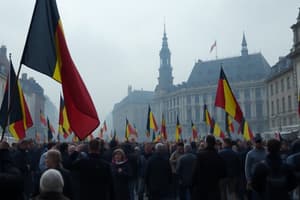Podcast
Questions and Answers
Wat was de technologische innovatie die plaatsvond tijdens de IJzertijd?
Wat was de technologische innovatie die plaatsvond tijdens de IJzertijd?
- Het gebruik van vee
- Het gebruik van metaalwerktuigen en wapens (correct)
- Het gebruik van landbouw
- Het gebruik van kunst
Wat is de datum van de Gallische Oorlog?
Wat is de datum van de Gallische Oorlog?
- 57 BC (correct)
- 45 AD
- 49 AD
- 54 AD
Wie was de leider van de opstand van de Batavi in 68-69 AD?
Wie was de leider van de opstand van de Batavi in 68-69 AD?
- Julius Caesar
- Tiberius
- Claudius
- Julius Civilis (correct)
Wat was de politieke strategie die Rome gebruikte om de Nederlandse stammen te veroveren?
Wat was de politieke strategie die Rome gebruikte om de Nederlandse stammen te veroveren?
Wat was de datum van de terugtrekking van de laatste Romeinse troepen uit Nederland?
Wat was de datum van de terugtrekking van de laatste Romeinse troepen uit Nederland?
Flashcards are hidden until you start studying
Study Notes
-
In the late Bronze Age, a culture of Urnfield farmers developed in central and southern Belgium and southern Netherlands.
-
The culture had similarities to other cultures in western Europe and was part of a network of exchanges.
-
In the Iron Age, the culture spread to northern Germany.
-
The IJzertijd was a time of technological innovation and increased food production.
-
The elites of the culture were those who owned livestock and made use of metal tools and weapons.
-
Egalitarian societies were gradually replaced by aristocratic ones due to the influx of Germanic people in the second century BC.
-
The Germanic peoples had different gods and religions than the Celts, which led to conflicts.
-
The first written records of the Netherlands come from the Romans, who would eventually stay there for hundreds of years.
-
In 57 BC, General Julius Caesar fought the Belgae in the southern Netherlands. This Gallic War marked the transition from prehistory to history in the area of present-day Netherlands.
-
From the 12th century onwards, more sources begin to exist. However, much of the history from this period is still unknown.
-
The Roman period saw the emergence of several Dutch "Belgian" tribes, including the Menapii and the Eburones. They were initially successful in their guerrilla warfare, but eventually surrendered.
-
In the years following the Roman Civil War (49-45 AD), Augustus established Gallia Belgica, dividing the territory to the left of the Rhine into two parts.
-
Under the reigns of Tiberius (14-37 AD) and Claudius (41-54 AD), Romanization became an important political tool in the Netherlands. Dutch "Belgian" tribes were granted the status of "civitas libera" or "civitas foederata", which granted them some degree of independence.
-
In 68-69 AD, under the leadership of Julius Civilis, the Batavi revolted when the Roman legions withdrew from the Rhine to fight the internal succession war in Rome.
-
Under the rule of Vespasianus (69-79 AD), the rebellious areas were brought back under Roman control. General Cerialis then launched a campaign to pacify the Dutch tribes.
-
After the death of Vespasianus in 79 AD, the Roman Empire began to decline. The Dutch started to rebel again, this time with more success.
-
In the year 68, Julius Civilis led a revolt against the Roman Empire in the north.
-
In the year 69, the Batavi revolted again when the Roman legions withdrew from the Rhine to fight the internal succession war in Rome.
-
In the year 71, the Roman Empire collapsed and the Dutch started to rebel more successfully.
-
In the year 74, the last Roman troops withdrew from the Netherlands. The Dutch then became fully independent.
Studying That Suits You
Use AI to generate personalized quizzes and flashcards to suit your learning preferences.



